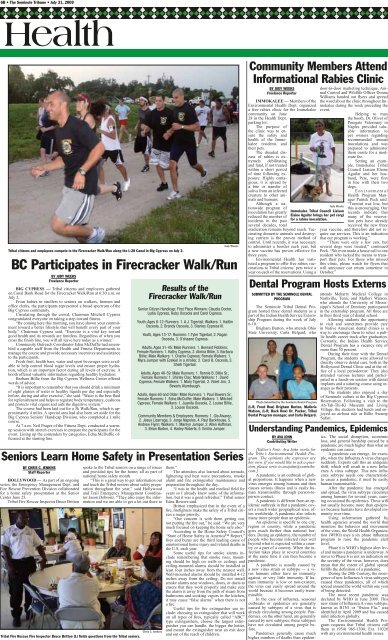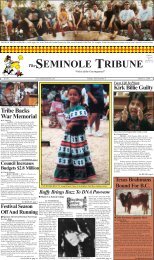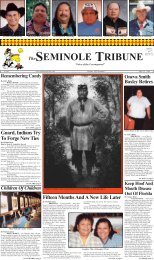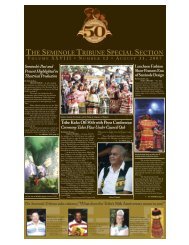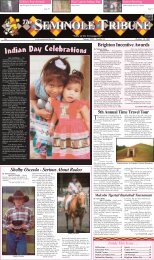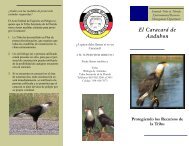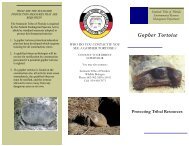6B • The <strong>Seminole</strong> Tribune • July 31, 2009Judy WeeksTribal citizens and employees compete in the Firecracker Walk/Run along the L-28 Canal in Big Cypress on July 2.BC Particip<strong>at</strong>es in Firecracker Walk/RunBIG CYPRESS — Tribal citizens and employees g<strong>at</strong>heredon Canal Bank Road for the Firecracker Walk/Run <strong>at</strong> 6:30 a.m. onJuly 2.From babies in strollers to seniors on walkers, firemen andoffice clerks, the participants represented a broad spectrum of theBig Cypress community.Circul<strong>at</strong>ing through the crowd, Chairman Mitchell Cypresscongr<strong>at</strong>ul<strong>at</strong>ed everyone on taking a step toward fitness.“By coming here this morning, you have shown your commitmenttoward a better lifestyle th<strong>at</strong> will benefit every part of yourbody,” Chairman Cypress said. “Exercise is a vital key towardgood health and its rewards are limitless. Regardless of when youcross the finish line, you will all leave here today as a winner.’Community Outreach Coordin<strong>at</strong>or Edna McDuffie had assembleda capable staff from the Health and Fitness Departments tomanage the course and provide necessary incentives and assistanceto the participants.Fresh fruit, health bars, w<strong>at</strong>er and sport beverages were availableto help control blood sugar levels and ensure proper hydr<strong>at</strong>ion,which is an important factor during all levels of exercise. Abooth offered valuable inform<strong>at</strong>ion regarding healthy hydr<strong>at</strong>ion.Barbara Billie from the Big Cypress Wellness Center offeredwords of advice.“It is important to remember th<strong>at</strong> you should drink a minimumof eight glasses of w<strong>at</strong>er or healthy liquids per day and especiallybefore, during and after exercise,” she said. “W<strong>at</strong>er is the best fluidfor replenishment and helps to regul<strong>at</strong>e body temper<strong>at</strong>ure, cushionsand protects vital organs and aids the digestive system.”The course had been laid out for a 5k Walk/Run, which is approxim<strong>at</strong>ely4 miles. A special area had also been set aside for theBig Cypress Seniors’ Handicap Division, who completed a 1 milecourse.At 7 a.m. Neil Prager of the Fitness Dept. conducted a warmupsession with stretch exercises to prepare the participants for theevent. Lining up the contenders by c<strong>at</strong>egories, Edna McDuffie offici<strong>at</strong>ed<strong>at</strong> the starting line.Seniors Learn Home Safety in Present<strong>at</strong>ion SeriesBY CHRIS C. JENKINSStaff ReporterBY JUDY WEEKSFreelance ReporterHOLLYWOOD — As part of an ongoingseries, the Emergency Management Dept. andFire Rescue Prevention Division collabor<strong>at</strong>edfor a home safety present<strong>at</strong>ion <strong>at</strong> the SeniorCenter June 25.Tribal Fire Rescue Inspector Bruce Brittonspoke to the Tribal seniors on a range of issuesand provided tips for the home; all as part ofn<strong>at</strong>ional home safety month.“This is a gre<strong>at</strong> way to get inform<strong>at</strong>ion outand teach the Tribal seniors about safety prepar<strong>at</strong>ionthroughout the year,” said Hollywoodand Trail Emergency Management Coordin<strong>at</strong>orJason Dobronz. “They also enjoy the inform<strong>at</strong>ionand we are able to get a lot out there toChris C. JenkinsTribal Fire Rescue Fire Inspector Bruce Britton (L) fields questions from the Tribal seniors.Results of theFirecracker Walk/RunSenior Citizen Handicap: First Place Winners: Claudia Doctor,Lydia Cypress, Ruby Osceola and Carol Cypress.Youth, Ages 8-12: Runners: 1. A.J. Tigertail; Walkers: 1. KaitlinOsceola, 2. Brandy Osceola, 3. Stanley Cypress III.Youth, Ages 13-17: Runners: 1.Tyler Tigertail, 2. RaganOsceola, 3. O’shaane Cypress.Adults, Ages 31-45: Male Runners: 1. Bernard Robbins;Female Runners: 1. K<strong>at</strong>hy Cypress, 2. Almira Billie, 3. BarbaraBillie; Male Walkers: 1. Charlie Cypress; Female Walkers: 1.Myra Jumper with Ezekiel in a stroller, 2. Carol B. Osceola, 3.Shelli Tigertail.Adults, Ages 46-59: Male Runners: 1. Ronnie B. Billie Sr.;Female Runners: 1. Shirley Clay; Male Walkers: 1. DavidCypress; Female Walkers: 1. Mary Tigertail, 2. Violet Jim, 3.Beverly Alumbaugh.Adults, Ages 60 and Older: Male Runners: 1. Paul Bowers Sr.;Female Runners: 1. Edna McDuffi e; Male Walkers: 1. MitchellCypress; Female Walkers: 1. Juanita Osceola, 2. Louise Billie,3. Louise Osceola.Community Members & Employees: Runners: 1. Gio Alvarez,2. Jesus Lizarraga, 3. Jorge Napoles, 4. Paul Backhouse, 5.Andrew Flynn; Walkers: 1. Marilyn Jumper, 2. Allen Hoffman,3. Brian Barton, 4. Harley Roberts, 5. Emilia Jumper.them.”The <strong>at</strong>tendees also learned about tornado,lightening and he<strong>at</strong> wave precautions, smokealarm and fire extinguisher maintenance andprepar<strong>at</strong>ion throughout the day.“I was in the health and medical field foryears so I already knew some of the inform<strong>at</strong>ion,but it was a good refresher,” Tribal seniorEdna Bowers said.Britton emphasized th<strong>at</strong> in the event of afire, firefighters make the safety of a Tribal citizena major priority.“Our concern is with them getting out,not putting the fire out,” he said. “We are verymuch focused on keeping the home safe also.”According to the Home Safety Council’s“St<strong>at</strong>e of Home Safety in America Report,”fires and burns are the third leading cause ofunintentional home injury and rel<strong>at</strong>ed de<strong>at</strong>hs inthe U.S. each year.Some useful tips for smoke alarms includeremembering th<strong>at</strong> smoke rises, mountingshould be high on walls or ceilings andceiling-mounted alarms should be installed <strong>at</strong>least four inches away from the nearest wall.Wall-mounted alarms should be installed 4-12inches away from the ceiling. Do not installsmoke alarms near windows, doors, or ducts toensure th<strong>at</strong> they work properly and make surethe alarm is away from the p<strong>at</strong>h of steam fromb<strong>at</strong>hrooms and cooking vapors in the kitchen,it may cause “false alarms” when there is nota fire.Useful tips for fire extinguisher use include:choosing an extinguisher th<strong>at</strong> will workon all types of fires, typically called “ABC”type extinguishers, choose the largest extinguisheryou can handle, the bigger the better,and mount the extinguisher near an exit doorand out of the reach of children.Community Members AttendInform<strong>at</strong>ional Rabies ClinicBY JUDY WEEKSFreelance ReporterIMMOKALEE — Members of theEnvironmental Health Dept. organizeda free rabies clinic for the Immokaleecommunity on June28 in the Health Dept.parking lot.The purpose ofthe clinic was to ensurethe safety andhealth of the Immokaleeresidents andtheir pets.The dreaded diseaseof rabies is extremelydebilit<strong>at</strong>ingand f<strong>at</strong>al, if not tre<strong>at</strong>edwithin a short periodof time following exposure.Highly contagious,it is spread bya bite or transfer ofsaliva from an infectedcre<strong>at</strong>ure to other animalsand humans.Although a n<strong>at</strong>ionwideprogram ofinocul<strong>at</strong>ion has gre<strong>at</strong>lyreduced the number ofincidents in the pastseveral decades, totaleradic<strong>at</strong>ion remains beyond reach. Vaccin<strong>at</strong>ingdomestic animals and destroyingcarriers is the proven method ofcontrol. Until recently, it was necessaryto administer a booster each year, buta new vaccine has proven effective forthree years.Environmental Health has instituteda program to offer free rabies vaccin<strong>at</strong>ionsto Tribal citizens’ pets twice ayear on each of the reserv<strong>at</strong>ions. Using aDental Program Hosts ExternsSUBMITTED BY THE SEMINOLE DENTALPROGRAMThe <strong>Seminole</strong> Tribal Dental Programhosted three dental students as apart of the Indian Health Service ExternshipProgram during the week of July6-10.Brigham Burton, who <strong>at</strong>tends OhioSt<strong>at</strong>e University, Carla Belgard, whoPhoto Submitted by the <strong>Seminole</strong> Dental Program(L-R, Front Row) Brigham Burton, MallorieW<strong>at</strong>son, (L-R, Back Row) Dr. Packer, TribalDental Program manager, and Carla Belgard.door-to-door marketing technique, AnimalControl and Wildlife Officer DonnaWilliams handed out flyers and spreadthe word about the clinic throughout Immokaleeduring the week preceding theevent.Helping to manthe booth, Dr. Oliver ofPineg<strong>at</strong>e Veterinary inNaples provided valuableinform<strong>at</strong>ion topet owners regardingJudy WeeksImmokalee Tribal Council LiaisonElaine Aguilar brings her pet corgifor a rabies inocul<strong>at</strong>ion.recommended annualinocul<strong>at</strong>ions and wasprepared to administerthem onsite for a moder<strong>at</strong>efee.Setting an example,Immokalee TribalCouncil Liaison ElaineAguilar and her husband,Pete, were firstin line with their twodogs.EnvironmentalHealth Program ManagerP<strong>at</strong>rick Peck said:“Turnout was low, butthis is encouraging. Ourrecords indic<strong>at</strong>e th<strong>at</strong>many of the reserv<strong>at</strong>ionpets have alreadyreceived the new threeyear vaccine, and therefore did not requireour services. This is an indic<strong>at</strong>ionth<strong>at</strong> our program is working.”“There were only a few c<strong>at</strong>s, butseveral dogs were tre<strong>at</strong>ed,” continuedPeck. “We even made a house call to oneresident who lacked the means to transporttheir pets. For those who missedthis clinic, please w<strong>at</strong>ch for flyers th<strong>at</strong>will announce our return sometime inOctober.”<strong>at</strong>tends Meharry Medical College inNashville, Tenn, and Mallori W<strong>at</strong>son,who <strong>at</strong>tends the University of <strong>Miss</strong>issippi’sSchool of Dentistry particip<strong>at</strong>edin the externship program. All three arein their third year of dental school.Allowing students the opportunityto visit and sometimes provide carein N<strong>at</strong>ive American dental clinics is away to encourage them to select a publichealth career track after gradu<strong>at</strong>ion.Currently, the Indian Health ServiceDental Program has a vacancy r<strong>at</strong>e ofmore than 30 percent.During their time with the DentalProgram, the students were allowed todirectly observe dental care, both in theHollywood Dental Clinic and <strong>at</strong> the officeof a local periodontist. They also<strong>at</strong>tended various lectures and particip<strong>at</strong>edin a hands-on session with dentalimplants and a suturing course using orangesas their p<strong>at</strong>ients.The students also enjoyed a dayof <strong>Seminole</strong> culture <strong>at</strong> the Big CypressReserv<strong>at</strong>ion. Following a visit to theAh-Tah-Thi-Ki Museum and LivingVillage, the students had lunch and enjoyedan airbo<strong>at</strong> ride <strong>at</strong> Billie SwampSafari.Understanding Pandemics, EpidemicsBY AVA JOHNContributing Writer[Editor’s Note: Ava John works forthe Tribe’s Environmental Health Program.The opinions she expresses areher own. If you would like to ask a question,please write to avajohn@semtribe.com.]A pandemic is an outbreak of globalproportions. It happens when a newvirus emerges among humans and thencauses serious illness and is easily humantransmissible through person-topersoncontact.A pandemic is different from an epidemicoutbreak in th<strong>at</strong> a pandemic coversa much wider geographical area, oftenworldwide. A pandemic also infectsmany more people than an epidemic.An epidemic is specific to one city,region or country, while a pandemicgoes much further than n<strong>at</strong>ional borders.During an epidemic, the number ofpeople who become infected rises wellbeyond wh<strong>at</strong> is expected within a countryor a part of a country. When the infectiontakes place in several countries<strong>at</strong> the same time it can then become apandemic.A pandemic is usually caused bya new virus strain or subtype — a virushumans either have no immunityagainst, or very little immunity. If humanimmunity is low or non-existent,the virus can easily spread around theworld because it becomes easily transmissible.In the case of influenza, seasonaloutbreaks or epidemics are generallycaused by subtypes of a virus th<strong>at</strong> isalready circul<strong>at</strong>ing among people. Pandemics,on the other hand, are generallycaused by new subtypes; these subtypeshave not circul<strong>at</strong>ed among people before.Pandemics generally cause muchhigher numbers of de<strong>at</strong>hs than epidemics.The social disruption, economicloss, and general hardship caused by apandemic are much higher than wh<strong>at</strong> anepidemic can cause.A pandemic can emerge, for example,when the Influenza A virus changessuddenly. Experts call this an antigenicshift, which will result in a new InfluenzaA virus subtype. This new influenzasubtype needs one characteristicto cause a pandemic; it must be easilyhuman transmissible.After the pandemic has emergedand spread, the virus subtype circul<strong>at</strong>esamong humans for several years, causingoccasional flu epidemics. These willnot usually become more than epidemicsbecause humans have developed immunityover time.Using inform<strong>at</strong>ion g<strong>at</strong>hered byhealth agencies around the world th<strong>at</strong>monitors the behavior and movementof the virus, the World Health Organiz<strong>at</strong>ion(WHO) uses a six phase influenzaprogram to raise the pandemic alertlevel.Phase 6 is WHO’s highest alert leveland means a pandemic is underway. Amove to Phase 6 is not an indic<strong>at</strong>ion onthe severity of the virus, however, doesmean th<strong>at</strong> the extent of global spreadfulfills the definition of a pandemic.During the 20th Century, the emergenceof new Influenza A virus subtypescaused three pandemics, all of whichspread around the world within one yearof being detected.The most recent pandemic wasdeclared by WHO in June 2009. Thisnew strain of Influenza A virus subtype,known as H1N1 or “Swine Flu,” wasidentified in April 2009 and has causedmild infection globally.The Environmental Health Programrequests th<strong>at</strong> Tribal citizens callthem <strong>at</strong> (954) 965-1300, Ext. 10326with any environmental health issues.
THE HEALTHY SENIOR BY FRED CICETTI[Editor’s Note: Fred Cicetti is a syndic<strong>at</strong>ed columnistwho writes about issues concerning seniorcitizens’ health. This is parts 1 and 2 of a 2-part columnabout understanding sunscreens and sun exposure.The opinions he expresses are his own. If youwould like to ask a question, please write to fred@healthygeezer.com. All Rights Reserved ©2009 byFred Cicetti.]Q: There are lots of sunblocks out there with SPFnumbers on them. Wh<strong>at</strong> exactly do these numbersmean?A: Sunblocks, or sunscreens, work to prevent thedamage of ultraviolet (UV) rays, an invisible componentof sunlight. There are three types of UV rays:UVA, UVB and UVC.UVA is the most abundant of the three ultravioletrays <strong>at</strong> the earth’s surface. These rays penetr<strong>at</strong>ethrough the outer skin. Many of the UVB rays areabsorbed by the str<strong>at</strong>ospheric ozone layer, so therearen’t as many of these <strong>at</strong> the earth’s surface as theUVA rays. UVB rays don’t penetr<strong>at</strong>e as far as UVArays but are still harmful. UVC radi<strong>at</strong>ion is extremelyhazardous to skin, but it is completely absorbed bythe ozone layer.Sunburn and suntan are signs of skin damage.Suntans appear after the sun’s rays have already killedsome cells and damaged others. UV rays do moreharm than damaging skin. They can also cause c<strong>at</strong>aracts,wrinkles, age spots, and skin cancer.Sunscreens are given SPF (Sun Protection Factor)r<strong>at</strong>ings th<strong>at</strong> tell you how well they protect youfrom damaging rays from the sun. The SPF r<strong>at</strong>ingscan be as low as 2 and as high as 100 or more.Here’s how the r<strong>at</strong>ings work: If you apply a sunscreenr<strong>at</strong>ed <strong>at</strong> SPF 2, you will double the time it takesfor your skin to burn. A sunscreen r<strong>at</strong>ed <strong>at</strong> SPF 15 willmultiply the burning time by 15.Derm<strong>at</strong>ologists strongly recommend using abroad-spectrum (UVA and UVB protection) sunscreenwith an SPF of 15 or gre<strong>at</strong>er year-round forall skin types.The SPF number indic<strong>at</strong>es the screening abilityfor UVB rays only. Research is being to done to establisha system to measure UVA protection.There is a point of diminishing returns with sunscreens.Here’s how it goes:A sunscreen with an SPF of 2 screens 50 percentof UVB rays; a sunscreen with an SPF of 15 screens93 percent of UVB rays; a sunscreen with an SPF of30 screens 97 percent of UVB rays, a sunscreen withan SPF of 50 blocks 98 percent of UVB rays; and, asunscreen with an SPF of 100 or more blocks 99 percentof UVB rays.Not applying enough sunscreen can seriouslyreduce your protection. You should use an ounce,or about a palm’s full, on your body to gain the fullprotection indic<strong>at</strong>ed by the SPF on the product. Also,derm<strong>at</strong>ologists advise reapplic<strong>at</strong>ion every two hoursor after swimming or swe<strong>at</strong>ing.It seems logical th<strong>at</strong>, if you use half the requiredsunscreen, you will get only half the protection, butth<strong>at</strong> doesn’t seem to be true. A study in the BritishJournal of Derm<strong>at</strong>ology found th<strong>at</strong> you get the protectionof only the square root of the SPF. So, in theory,if you use a half ounce of sunscreen r<strong>at</strong>ed <strong>at</strong> 64, youwon’t get the protection of an SPF 32, but only theprotection of an SPF 8.In addition to applying a sunscreen, you shouldprotect yourself by avoiding the sun between 10 a.m.and 4 p.m., wearing protective clothing and wraparoundsunglasses, avoiding sunlamps and tanningbeds, and checking your skin regularly for changesin the size, shape, color or feel of birthmarks, molesand spots.Ultraviolet (UV) rays, an invisible component ofsunlight, can cause skin damage, c<strong>at</strong>aracts, wrinkles,age spots, and skin cancer. These rays also impair theskin’s immune system.UV rays can hurt you on cloudy as well as sunnydays. UV rays also bounce off surfaces of the ocean,sand, snow and cement.One of the surest ways to reduce your exposureto UV rays is to stay out of the sun when it is thestrongest. Those times in North America are between10 a.m. and 4 p.m. in the l<strong>at</strong>e spring and early summer.Other ways to protect yourself are to wearprotective clothing, such as a wide-brimmed h<strong>at</strong>,long-sleeved shirt and long pants. You should use asunscreen r<strong>at</strong>ed <strong>at</strong> SPF 15 or more. Eye doctors recommendwraparound sunglasses th<strong>at</strong> provide 100percent UV ray protection.You should also pay <strong>at</strong>tention to the UV Indexdeveloped by the N<strong>at</strong>ional We<strong>at</strong>her Service and theEnvironmental Protection Agency. This index assessesrisk of overexposure to UV rays.The UV Index is calcul<strong>at</strong>ed daily and is reportedby the press. It can be found <strong>at</strong>: http://www.epa.gov/sunwise/uvindex.html, where you can plug in yourown zip code to find out the index r<strong>at</strong>ing in your area.The following are the index levels: 2 or less: lowdanger for the average person, 3-5: moder<strong>at</strong>e risk ofharm, 6-7: high risk of harm, 8-10: very high risk ofharm, and, 11 or more: extreme risk of harm.It is possible to go outside when the UV Index is11 or higher but you must be sure to take every steppossible to protect yourself, meaning use sunscreenand wear h<strong>at</strong>s, long sleeves and sunglasses.Not everyone reacts to the sun in the same way.The level of danger calcul<strong>at</strong>ed for the basic c<strong>at</strong>egoriesof the UV Index are for a person with Type II skin.The following is a list of the skin types: I: alwaysburns, never tans, sensitive to sun exposure, II: burnseasily, tans minimally, III: burns moder<strong>at</strong>ely, tansgradually to light brown, IV: burns minimally, alwaystans well to moder<strong>at</strong>ely brown, V: rarely burns, tansprofusely to dark, and, VI: Never burns, deeply pigmented,least sensitiveWh<strong>at</strong> is a suntan?When UV rays penetr<strong>at</strong>e the skin’s inner layerthey gener<strong>at</strong>e the production of melanin, a dark pigment.The melanin eventually moves toward the outerlayers of the skin and becomes visible as a tan. Everytime you tan, you damage your skin and this damageaccumul<strong>at</strong>es over time.There is no safe tan. Wh<strong>at</strong> some call a “base tan”may actually increase the chances you’ll get a burn,because you’re likely to stay out longer without properlyprotecting your skin.You should stay away from tanning beds and sunlampsbecause they emit UV rays th<strong>at</strong> can cause seriouslong-term skin damage. The amount of the radi<strong>at</strong>ionproduced during indoor tanning is similar to thesun’s production and in some cases may be gre<strong>at</strong>er.Many tanning salons are unregul<strong>at</strong>ed. They allowcustomers access to tanning beds without supervisionor eye protection.July 31, 2009 • The <strong>Seminole</strong> Tribune • 7BBeware the Dangers of Extreme He<strong>at</strong>BY BRIAN BROWNContributing Writer[Editor’s Note: Brian Brown is the Tribe’s Chief ofthe EMS Division. The opinions he expresses are hisown. If you would like to ask a question, please write tobrianbrown@semtribe.com.]Our bodies normally cool by swe<strong>at</strong>ing. But undersome conditions, swe<strong>at</strong>ing just isn’t enough. In suchcases, a person’s body temper<strong>at</strong>ure rises rapidly. Veryhigh body temper<strong>at</strong>ures may damage the brain or othervital organs and can lead to de<strong>at</strong>h.Several factors affect your body’s ability to coolitself during extremely hot we<strong>at</strong>her. When the humidityis high, swe<strong>at</strong> doesn’t evapor<strong>at</strong>e as quickly, whichprevents your body from releasing he<strong>at</strong> quickly. Otherconditions rel<strong>at</strong>ed to risk include age, obesity, fever,dehydr<strong>at</strong>ion, heart disease, mental illness, poor circul<strong>at</strong>ion,sunburn and prescription drug and alcohol use.After the storm, it’s important to balance yourclean-up activities with measures th<strong>at</strong> help your body’scooling mechanisms and prevent he<strong>at</strong>-rel<strong>at</strong>ed illnessWh<strong>at</strong> Is Extreme He<strong>at</strong>?Temper<strong>at</strong>ures th<strong>at</strong> are 10 degrees or more above theaverage high temper<strong>at</strong>ure for your region and last forseveral weeks are defined as extreme he<strong>at</strong>. Excessivelydry and hot conditions can provoke dust storms and lowvisibility. Droughts occur when a long period passeswithout substantial rainfall. A he<strong>at</strong> wave combined witha drought is a very dangerous situ<strong>at</strong>ion.During Hot We<strong>at</strong>herTo protect your health when temper<strong>at</strong>ures are extremelyhigh, remember to keep cool and use commonsense. The following tips are important:Drink Plenty of FluidsDuring hot we<strong>at</strong>her you’ll need to increase yourfluid intake, regardless of your activity level. Don’t waituntil you’re thirsty to drink. In a hot environment, drinktwo to four glasses <strong>at</strong> 16-32 ounces each of cool fluidseach hour. If your doctor generally limits the amount offluid you drink or has you on w<strong>at</strong>er pills, ask how muchyou should drink while the we<strong>at</strong>her is hot.Avoid Alcoholic, Sugary BeveragesDon’t drink liquids th<strong>at</strong> contain alcohol or largeamounts of sugar. They actually cause you to lose morebody fluid. Also avoid very cold drinks, because theycan cause stomach cramps.Replace Salt and MineralsHeavy swe<strong>at</strong>ing removes salt and minerals fromthe body. These are necessary for your body and mustbe replaced. If you must exercise, drink two to fourglasses of cool, non-alcoholic fluids each hour. A sportsbeverage can replace the salt and minerals you lose inswe<strong>at</strong>. However, if you are on a low-salt diet, talk withyour doctor before drinking a sports beverage or takingsalt tablets.Wear Appropri<strong>at</strong>e Clothing and SunscreenChoose lightweight, light-colored and loose-fittingclothing. Besides causing pain and skin damage, sunburnaffects your body’s ability to cool itself and causesa loss of body fluids. If you must go outdoors, protectyourself from the sun by wearing a wide-brimmed h<strong>at</strong>,which also keeps you cooler, along with sunglasses andapply sunscreen of SPF 15 or higher 30 minutes prior togoing out. Continue to reapply it according to the packagedirections.Schedule Outdoor Activities CarefullyIf you must be outdoors, try to limit your outdooractivity to morning and evening hours. Try to rest oftenin shady areas so th<strong>at</strong> your body’s thermost<strong>at</strong> will havea chance to recover.Pace YourselfIf you aren’t used to working in a hot environment,start slowly and pick up the pace gradually. If exertionin the he<strong>at</strong> makes your heart pound and leaves yougasping for bre<strong>at</strong>h, stop all activity. Get into a cool areaor <strong>at</strong> least into the shade and rest, especially if you becomelightheaded, confused, weak or faint.Stay Cool IndoorsStay indoors and, if <strong>at</strong> all possible, stay in an airconditioned place. If your home doesn’t have air conditioning,try to go to the shopping mall or public library.Even a few hours spent in air conditioning can helpyour body stay cooler when you go back into the he<strong>at</strong>.Electric fans provide some comfort, but when the temper<strong>at</strong>ureis in the high 90s, fans will not prevent he<strong>at</strong>rel<strong>at</strong>edillness. Taking a cool shower or moving to anair conditioned place is a much better way to cool off.Use the Buddy SystemWhen working in the he<strong>at</strong>, monitor the conditionof your neighbors and have someone do the same foryou. He<strong>at</strong>-induced illness can cause a person to becomeconfused or lose consciousness. If you’re 65 years ofage or older, have someone check on you twice a day. Ifyou know someone in this age group, check on them <strong>at</strong>least twice a day.Monitor Those <strong>at</strong> High RiskAlthough anyone can suffer from he<strong>at</strong>-rel<strong>at</strong>ed illness,some people are <strong>at</strong> gre<strong>at</strong>er risk than others. Visitthese individuals <strong>at</strong> least twice a day and w<strong>at</strong>ch themfor signs of he<strong>at</strong> exhaustion or he<strong>at</strong> stroke. Infants andyoung children need much more frequent w<strong>at</strong>ching.Infants and children up to 4 years of age are sensitiveto the effects of high temper<strong>at</strong>ures and need othersto provide adequ<strong>at</strong>e liquids.People 65 years of age or older may not compens<strong>at</strong>efor he<strong>at</strong> stress efficiently and are less likely to senseand respond to changes in temper<strong>at</strong>ure.People who are overweight may be prone to he<strong>at</strong>sickness because they tend to retain more body he<strong>at</strong>.People who overexert during work or exercise maybecome dehydr<strong>at</strong>ed and susceptible to he<strong>at</strong> sickness.People who are physically ill, especially with heartdisease or high blood pressure, or who take certainmedic<strong>at</strong>ions, such as for depression, insomnia, or poorcircul<strong>at</strong>ion, may be affected by extreme he<strong>at</strong>.Adjust to the EnvironmentKeep in mind th<strong>at</strong> any sudden change in temper<strong>at</strong>urewill be stressful to your body. You will havea gre<strong>at</strong>er tolerance for he<strong>at</strong> if you limit your physicalactivity until you become accustomed to the he<strong>at</strong>. If youtravel to a hotter clim<strong>at</strong>e, allow several days to becomeacclim<strong>at</strong>ed before <strong>at</strong>tempting any vigorous activity andwork up to it gradually.Use Common SenseRemember to keep cool and use common sense:Avoid hot foods and heavy meals th<strong>at</strong> add he<strong>at</strong>.Drink plenty of fluids and replace salts and mineralsin your body.Dress infants and children in cool, loose clothingand shade their heads and faces.Limit sun exposure during mid-day hours and inplaces of potential severe exposure such as beaches.Do not leave children, or pets in a parked car.Provide plenty of fresh w<strong>at</strong>er for your pets, andleave the w<strong>at</strong>er in a shady area.Even short periods of high temper<strong>at</strong>ures can causeserious health problems.SEEKING ORAL HISTORIESFOR MUSEUM COLLECTION ANDVETERAN’S MEMORIAL BUILDING EXHIBITThe Ah-Tah-Thi-Ki Museum is seeking to conduct oral history interviews with <strong>Seminole</strong>veterans and family members of veterans. The interviews will become a part of the existingoral history collection of the Tribal Museum. In the interview, you may choose wh<strong>at</strong> youwould like to speak about. If you give permission, the interview might be considered foruse in the exhibits to be cre<strong>at</strong>ed within the new Veteran’s Memorial Building in Brighton.We hope th<strong>at</strong> <strong>Seminole</strong> veterans will share stories for the benefit of current and futuregener<strong>at</strong>ions, as we look to honor your dedic<strong>at</strong>ion and service.To particip<strong>at</strong>e contact:Elizabeth LowmanOral History Coordin<strong>at</strong>orPhone: 863-903-1113 ext. 12210elizabethlowman@semtribe.com


